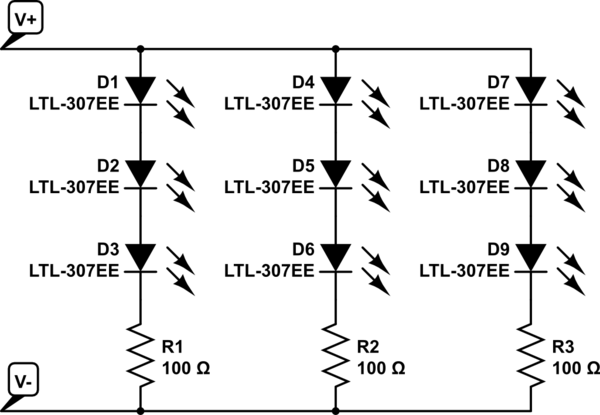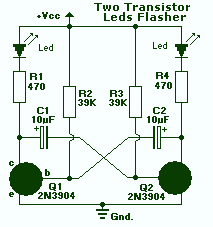
STEREO LED VU METER

This circuit offers a cost-effective alternative to the LM3915 series LED displays. It utilizes a square-wave oscillator constructed with two CMOS analog switches, which alternately select the right and left channels for monitoring and display. The chosen signal is amplified by a common-emitter stage (T1), and the output is directed to a series of comparators that control the display. These eight comparators are derived from two LM324 quad op-amps, each connected to a resistor network that provides a 3dB step between each comparator. Each comparator features a positive feedback resistor to enhance hysteresis, resulting in a prolonged display that alternates at approximately 10 kHz. The two CMOS switches are biased at half the supply voltage using 1 MΩ resistors from a 100 kΩ divider, allowing them to manage analog signals up to 9 V peak-to-peak. As the voltage exceeds the setpoint of each comparator, the output transitions low, activating the corresponding LED and creating a bar of light in response to the input voltage. For a linear response, the resistor network can be substituted with nine 10 kΩ resistors, providing an equal voltage gap before each LED activates.
This circuit design employs a square-wave oscillator to create a visually responsive LED display that indicates varying voltage levels. The use of CMOS analog switches enables efficient channel selection, ensuring that the circuit can monitor two input signals alternately. The common-emitter amplifier stage (T1) is critical for boosting the input signal to a level suitable for processing by the comparators.
The LM324 quad op-amps serve as the core of the comparator network, providing eight individual comparators that respond to specific voltage thresholds. The resistor network connected to each comparator introduces a 3dB voltage step, allowing for a graduated display of the input signal. The feedback mechanism in each comparator enhances stability and ensures that the display remains illuminated longer as the input signal fluctuates.
The biasing arrangement for the CMOS switches, achieved through a voltage divider, is essential for enabling the circuit to handle a significant range of input voltages. This design choice ensures that the circuit operates effectively within the specified range without distortion. The activation of the LEDs in response to the input voltage creates a visual representation of voltage levels, making it an effective tool for monitoring.
For applications requiring a linear response, the substitution of the resistor network with nine 10 kΩ resistors allows for a consistent voltage increment, improving the accuracy of the display. This flexibility in design makes the circuit suitable for various applications, including audio level monitoring, battery level indicators, and other voltage measurement tasks where a visual output is beneficial. Overall, the circuit combines simplicity and functionality, providing a reliable and cost-effective solution for LED voltage display applications.This circuit provides a cheap alternative to the LM3915 series LED displays. The meter relies on a square-wave oscillator built around two CMOS analog switches, which alternatively selects the right and left channels for monitoring and display. The selected signal is amplifted by the common-emitter stage T1, and the output is fed into the string c
omparators which control the display. These eight comparators are from two LM324 quad op amps, each is connected to a resistor network, which has a 3dB step between each comparator. Each comparator has a positive feedback resistor to increase the hysteresis to provide a longer display, which is switched altematively at about 10 kHz.
The two CMOS switches in line are biased at half the supply voltage by 1-M © resistors from a 100-k © divider, which allows them to handle analog signals up to 9 V peak to peak. As the voltage increases above the setpoint of each comparator, the output goes low and the corresponding LED lights, which produces a bar of light in response to the input voltage.
For a linear response the resistor-network can be replaced by nine 10-k © resistors, giving an equal voltage gap before each LED comes on. 🔗 External reference
This circuit design employs a square-wave oscillator to create a visually responsive LED display that indicates varying voltage levels. The use of CMOS analog switches enables efficient channel selection, ensuring that the circuit can monitor two input signals alternately. The common-emitter amplifier stage (T1) is critical for boosting the input signal to a level suitable for processing by the comparators.
The LM324 quad op-amps serve as the core of the comparator network, providing eight individual comparators that respond to specific voltage thresholds. The resistor network connected to each comparator introduces a 3dB voltage step, allowing for a graduated display of the input signal. The feedback mechanism in each comparator enhances stability and ensures that the display remains illuminated longer as the input signal fluctuates.
The biasing arrangement for the CMOS switches, achieved through a voltage divider, is essential for enabling the circuit to handle a significant range of input voltages. This design choice ensures that the circuit operates effectively within the specified range without distortion. The activation of the LEDs in response to the input voltage creates a visual representation of voltage levels, making it an effective tool for monitoring.
For applications requiring a linear response, the substitution of the resistor network with nine 10 kΩ resistors allows for a consistent voltage increment, improving the accuracy of the display. This flexibility in design makes the circuit suitable for various applications, including audio level monitoring, battery level indicators, and other voltage measurement tasks where a visual output is beneficial. Overall, the circuit combines simplicity and functionality, providing a reliable and cost-effective solution for LED voltage display applications.This circuit provides a cheap alternative to the LM3915 series LED displays. The meter relies on a square-wave oscillator built around two CMOS analog switches, which alternatively selects the right and left channels for monitoring and display. The selected signal is amplifted by the common-emitter stage T1, and the output is fed into the string c
omparators which control the display. These eight comparators are from two LM324 quad op amps, each is connected to a resistor network, which has a 3dB step between each comparator. Each comparator has a positive feedback resistor to increase the hysteresis to provide a longer display, which is switched altematively at about 10 kHz.
The two CMOS switches in line are biased at half the supply voltage by 1-M © resistors from a 100-k © divider, which allows them to handle analog signals up to 9 V peak to peak. As the voltage increases above the setpoint of each comparator, the output goes low and the corresponding LED lights, which produces a bar of light in response to the input voltage.
For a linear response the resistor-network can be replaced by nine 10-k © resistors, giving an equal voltage gap before each LED comes on. 🔗 External reference
Warning: include(partials/cookie-banner.php): Failed to open stream: Permission denied in /var/www/html/nextgr/view-circuit.php on line 713
Warning: include(): Failed opening 'partials/cookie-banner.php' for inclusion (include_path='.:/usr/share/php') in /var/www/html/nextgr/view-circuit.php on line 713





